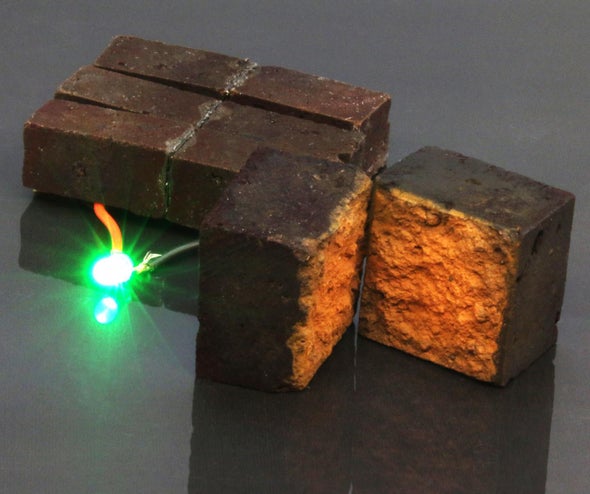(单词翻译:单击)
听力文本
This is Scientific American's 60-second Science, I'm Shahla Farzan.
Bricks are one of the oldest known building materials, dating back thousands of years.
But researchers at Washington University in St. Louis have found a new use for bricks: as energy storage units. A team of engineers and chemists have found a way to transform an ordinary house brick into a pseudo-battery—allowing it to conduct and store electricity.
The bricks are powerful enough to illuminate an LED light bulb and cost only about $3 to make.
"I love the idea of adding value to things that are inexpensive, things that are affordable, things that we kind of take for granted."
Julio D'Arcy is an assistant professor of chemistry at Washington University and one of the researchers on this project.
The brick battery relies on the reddish pigment known as iron oxide, or rust, that gives red bricks their color. The scientists pumped the bricks with several gases that react with iron oxide to produce a network of plastic fibers. These microscopic fibers coat the empty spaces inside the bricks—and conduct electricity.

"What we're trying to do is: we're trying to make specialized plastics that are only used on the nanoscale—where we use very little of the plastic, and we can actually embed that plastic inside construction materials that can store energy."
The study is in the journal Nature Communications.
In the future, D'Arcy says,a brick wall could potentially serve a dual purpose: providing structural support and storing electricity generated from renewable energy sources, such as solar panels.
The technology is still at least a few years away from being ready for the commercial market. And right now the energy storage capacity of the bricks is still pretty low—about 1 percent of a lithium ion battery. But the team is now testing ways to improve brick performance—because it looks like you can teach an old brick new tricks.
For Scientific American's 60-second Science. I'm Shahla Farzan.
参考译文
这里是科学美国人——60秒科学系列,我是莎拉·法赞。
砖是已知最古老的建筑材料之一,可以追溯到几千年前。
但圣路易斯华盛顿大学的研究人员发现了砖的新用途:能量储存单元。一个由工程师和化学家组成的团队找到了一种方法,可以将普通的房屋用砖转变成伪电池,使其能够传导和储存电力。
这些砖的能量足以点亮一个LED灯泡,制造成本仅为3美元左右。
“我喜欢为不贵、负担得起以及我们认为理所当然的东西增加价值的想法。”
该项目研究人员之一、华盛顿大学化学助理教授胡里奥·达西说到。
砖电池依赖于红色颜料氧化铁,或铁锈,这种颜料赋予了红砖颜色。科学家向砖块中注入几种气体,使其与氧化铁发生反应,生成塑料纤维网。这些微小的纤维覆盖砖块内部的空隙并导电。
“我们试图做的是:我们正在努力制造只在纳米尺度上使用的专用塑料,这样我们使用的塑料量很少,我们可以将塑料嵌入可储存能量的建筑材料中。”
这项研究发表在《自然·通讯》期刊上。
达西表示,在未来,砖墙可能有双种潜在用途:提供结构支撑以及储存太阳能板等可再生能源产生的电力。
这项技术距离进入商业市场至少还有几年的时间。目前,砖块的储能能力仍然相当低,约为锂离子电池的1%。但这个团队现在正在测试提高砖块性能的方法,因为看起来你可以教老砖学新招。
谢谢大家收听科学美国人——60秒科学。我是莎拉·法赞。
译文为可可英语翻译,未经授权请勿转载!
重点讲解
重点讲解:
1. date back 追溯(到);开始(于);始造(或建)(于);
The mastery and skills of cooking in China date back thousands of years.
中国在烹饪方面的优势和技艺可以追溯到几千年前。
2. transform into 转换;改变;改造;
Your metabolic rate is the speed at which your body transforms food into energy.
新陈代谢率是身体把食物转换为能量的速度。
3. take for granted 认为…是理所当然的;
Mary took it for granted that they would approve of the idea.
玛丽想当然地认为他们一定会同意这个想法。
4. rely on 依赖;依靠;
Once customers come to rely on these systems they almost never take their business elsewhere.
顾客一旦依赖上这些系统,几乎就不会光顾其他商家。
关注微信公众号【可可双语精读】,获取详细讲解内容


